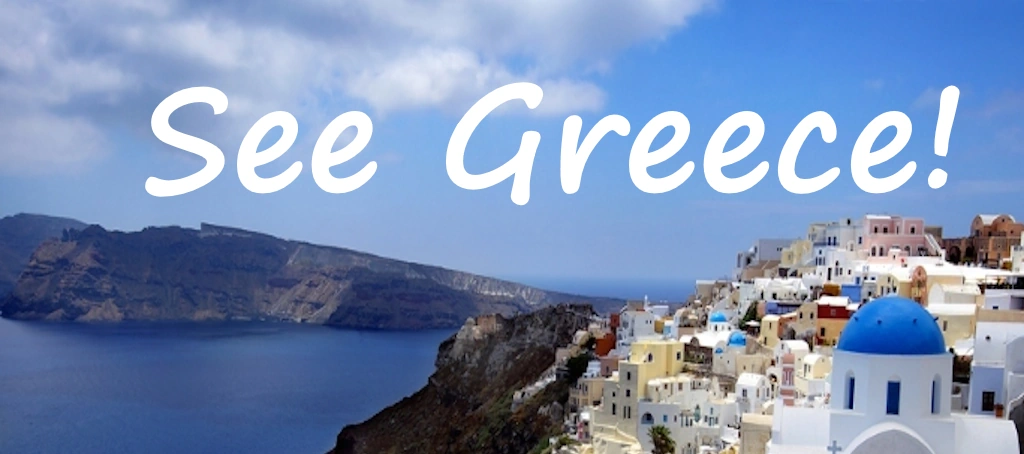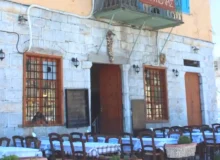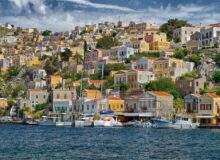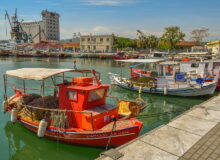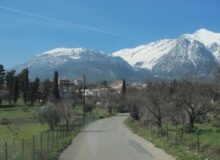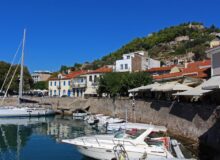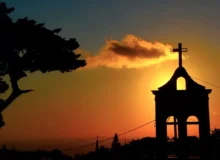Eretria
See Greece’s guide to Ancient Eretria, the most important historical site on Evia, a city that at one time fought with Chalkida for dominance of the island.

Eretria, a coastal gem on the Greek island of Evia, offers a rich tapestry of ancient history, stunning archaeological remains, and a museum that brings its storied past to life—making it a must-visit for history lovers and curious travelers alike.
📍 Eretria: Location and Setting

Map (c) Google Maps
Eretria is located on the western coast of Evia, directly across the South Euboean Gulf from the region of Attica. It’s about a half-hour drive from Chalkida. This strategic position made Eretria a vital maritime hub in antiquity, connecting it to the Greek mainland and the broader Mediterranean world. Today, the modern town of Eretria sits atop the ruins of its ancient predecessor, offering visitors a unique blend of seaside charm and archaeological intrigue.
🏛️ Historical Overview

Prehistoric and Early Settlements
The earliest traces of human activity in Eretria date back to the Neolithic period (3500–3000 BC), with pottery shards and stone tools discovered on the Acropolis and surrounding plains. During the Early Helladic period (3000–2000 BC), a small settlement emerged on the plain, featuring granaries and kilns. However, flooding forced inhabitants to relocate to the Acropolis during the Middle Helladic period (2000–1600 BC). By the Late Helladic period (1600–1100 BC), the site was sparsely populated and likely served as an observation post.
Archaic to Classical Period
Eretria truly flourished during the Greek Dark Ages and Archaic period, emerging as a powerful city-state alongside its rival, Chalcis. The city played a pivotal role in the Greek colonization movement, founding colonies in Italy (Pithekoussai and Cumae), Halkidiki, and the Black Sea region. Eretria’s influence extended to the development of the Greek alphabet, adapted from Phoenician script around the 8th century BC—a foundational moment for Western literacy.
Eretria’s military and political might were evident in its control over nearby islands like Andros, Tenos, and Ceos, and its involvement in the Lelantine War against Chalcis. The city also contributed ships to the Trojan War, as mentioned by Homer in the Iliad.
Persian and Roman Destruction
In 490 BC, Eretria was destroyed by the Persians during the Greco-Persian Wars. Though it recovered, the city faced further devastation in 198 BC when it was plundered by the Romans, and again in 87 BC during the Mithridatic Wars, leading to its decline.
🏺 Archaeological Site Highlights

The ancient city of Eretria lies beneath the modern town, with many structures excavated and partially restored:
- Sanctuary of Apollo Daphniforos: This central temple complex dates from the 8th to 5th century BC, with preserved foundations and sculptural fragments from its Doric temple (520–490 BC).
- Monumental Fountain: Located southeast of the temple, this 4th-century BC structure features a colonnade and served as a public water source.
- City Walls: Remnants of Eretria’s classical fortifications (4th century BC) still trace the coastline and descend from the Acropolis.
- Heroon: A Geometric-period burial site (750–680 BC) near the western gate, containing aristocratic graves and votive offerings.
- House with Mosaics: A luxurious 4th-century BC residence showcasing intricate floor mosaics, located along the city’s main artery.
- Theater: Built in the 5th and 4th centuries BC, the theater is one of Eretria’s most iconic landmarks, offering insight into ancient performance culture.
- Sanctuaries and Public Buildings: These include the Temple of Dionysus, sanctuary of Isis, Thesmophorium, and sanctuary of Artemis, as well as gymnasiums, baths, and banquet halls.
- Macedonian Tombs: These elaborate burial structures reflect the city’s Hellenistic period and its connections to Macedonian culture.
🖼️ Archaeological Museum of Eretria
Located near the excavation site, the Archaeological Museum of Eretria is a treasure trove of artifacts that span millennia. It houses finds from Eretria itself, as well as nearby sites like Lefkadi and Amarynthos.
Museum Highlights:
- Polychrome Antefixes: Decorative roof tiles featuring mythological motifs, including Gorgons.
- Statues and Sculptures: Notably, a statue of a youth from the gymnasium, now displayed in the National Archaeological Museum in Athens.
- Pottery and Votive Offerings: Items from domestic and funerary contexts, including cups, figurines, and ceremonial vessels.
- Architectural Fragments: Columns, capitals, and sculptural reliefs from temples and public buildings.
- Funerary Artifacts: Grave goods from aristocratic burials, including jewelry, weapons, and inscriptions.
The museum provides context for the ruins and helps visitors visualize the grandeur of ancient Eretria.
🧭 Tips for Visiting Eretria
Visiting Eretria is both educational and scenic. Here are some tips to make the most of your trip:
- Best Time to Visit: Spring and early autumn offer pleasant weather and fewer crowds.
- Getting There: Eretria is accessible via ferry from Oropos on the mainland or by car from Chalkis, the capital of Evia.
- Local Attractions: Beyond the archaeological site, enjoy Eretria’s beaches, cafés, and waterfront promenade.
- Guided Tours: Consider joining a tour led by experts from the Swiss School of Archaeology, which has been excavating the site since 1964.
- Nearby Sites: Visit Amarynthos, known for its sanctuary of Artemis, and Lefkandi, another important prehistoric site.
- Dining and Accommodation: Eretria offers a range of traditional tavernas, boutique hotels, and guesthouses with views of the gulf.
🌟 Why Eretria Matters
Eretria’s legacy is woven into the fabric of Greek civilization—from its role in colonization and alphabet development to its architectural and artistic achievements. Though often overshadowed by more famous sites like Athens or Delphi, Eretria offers a quieter, more intimate encounter with antiquity.
Whether you’re a history buff, a curious traveler, or someone seeking a scenic escape, Eretria delivers a compelling blend of culture, heritage, and natural beauty.
Modern Eretria

In the centre of the modern town can be seen the foundations of the Temple of Apollo, and the site of the agora. The modern town now sprawls along the coast as one of the island’s main resorts, given its proximity to Chalkida, but while the remains of the ancient city ought to be seen, the modern town is not the most appealing place to stay on Evia. There are far lovelier towns and resorts all around the island.
